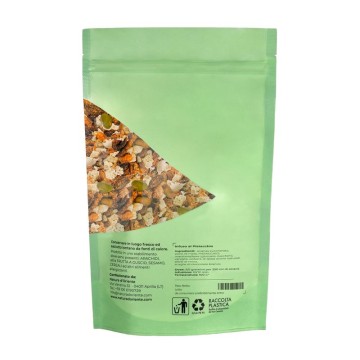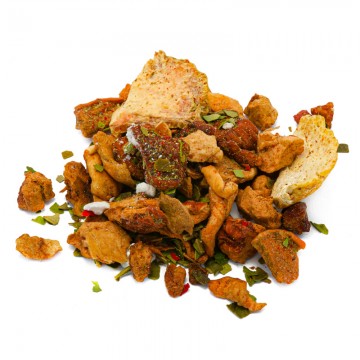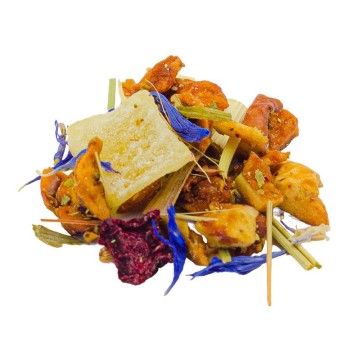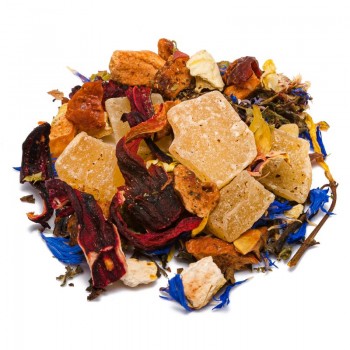Goodness and antioxidants come together in a drink full of beneficial elements but with a captivating taste. It is a mixture of inexhaustible delight, for those who love pistachio, which evokes the aromas and tastes of the Mediterranean. Plus, it's versatile; it can be used as an infusion to warm up in winter, but it is also excellent if consumed fresh during the summer months. With a drop of milk, it becomes a concentrate of sweetness also thanks to the other ingredients that enhance its flavour.
Pistachio infusion: properties and benefits
Among its nutritional characteristics, this pistachio infusion is a source of beneficial substances such as antioxidants and mineral salts - calcium, iron and magnesium. It represents a drink full of taste and nutrition, with several ingredients that make it exceptional. The base is given by pistachios, the edible seeds of the Pistacia vera plant, which contain healthy fats, vitamin B6 and thiamine, are a good source of protein, fiber and antioxidants. They are known for their delicious taste, but contain elements useful for the well-being of the heart and intestines. Antioxidants, as the name implies, prevent oxidation that damages our healthy cells.
They act protectively, and those contained in pistachios are abundant in quantity, compared to different varieties of nuts and seeds. We find antioxidants in pistachios for the well-being of vision such as lutein and zeaxanthin, as well as polyphenols and tocopherols. Substances that counteract aging thanks to the action against free radicals, which damage our cells. For the well-being of the heart, especially useful for those who smoke, pistachios are a source of L-arginine, a substance that will be converted in the body into the beneficial nitric oxide. It is this oxide that performs a good function on the blood vessels, favoring their vasodilation - on the contrary, the restriction of the vessels and blood flow leads to an increase in blood pressure and factors that can increase health risks.
Furthermore, pistachios are one of the foods richest in vitamin B6 – essential for the formation of hemoglobin, a molecule that carries oxygen in the Red blood cells. The mixture is also useful to the body through the content of the other ingredients including pineapple, apple and blackberry: vitamins C and group B, antioxidants, substances useful for digestion. For the well-being of the heart, the infusion contains the antioxidants anthocyanins, deriving from the blackberry; a fruit that makes magnesium available – useful for regulating blood pressure and blood vessel flow.
Pineapple contains the so-called bromelain, a set of protein enzymes that can promote the digestion of animal proteins and counteract irritations of the gastrointestinal tract. The apple helps with its potassium content, complementary to magnesium and useful for regulating blood pressure. The particular taste of the pistachio infusion is appreciated by those who taste it, thanks to the presence of exquisite elements such as white chocolate flakes and marshmallow.
Origins and History of cultivation
The blend features several natural elements. To create this infusion, various ingredients have been used: sugared pineapple, pieces of apple, pistachio, marshmallows, natural flavourings, blackberry pieces, white chocolate flakes. Speaking of the founding element, the pistachio is a food consumed by man for thousands of years – the evidence of its presence in human nutrition dates back to about 8,000 years ago. The legend of the Hanging Gardens of Babylon speaks of pistachio trees in 700 BC. and pistachios are also mentioned in the Old Testament. Over the centuries, they were also considered foods intended only for the elite due to their goodness, and in Classical Rome they are mentioned from the 1st century AD. They arrived from Syria to Italy and then spread throughout the Mediterranean. Pistachios have historically been used both to create desserts and in ground form to thicken sauces. They were highly appreciated for their exceptional nutritional value, being seeds rich in proteins, fats and fibres. Due to the long shelf life, they were easily transported by merchants along the ancient Silk Road. From Persian cuisine derive Arab desserts with pistachio, such as Baklava (buttered phyllo dough, alternated with layers of walnuts and dipped in a syrup). In Italy, the large and historic crops in Sicily make it a highly appreciated and used element in the kitchen, between desserts and savory recipes. Pistachio seeds today can be eaten fresh or toasted, used for desserts and ice creams; they are also used for yellowish-green coloringsome sweets.
Plant and flowers
The components of the infusion are many, and the mixture contains leaves and flowers of different origins. The pistachio comes from the Pistacia vera plant, a small tree of the cashew family – Anacardiaceae. These are edible seeds, highly appreciated in the kitchen. The plant is grown in dry soils, in warm or temperate climates. It has very extensive branches, but rarely exceeds 9 meters in height. Each leaf has thick and broad leaflets, while the flowers are male and female (it is generally a dioecious plant). The white drupe fruits grow in clusters, about 2 cm long. As they mature, they tend to divide without releasing the seed. Under the shell, the walnut shows a greenish stone enclosed in a thin, adherent reddish skin. The shelled and peeled kernels give the pleasant known flavour. The Malus domestica plant of the Rosaceae family gives us apples. It is a tree native to Asia, now spread all over the planet. The fruits differ in colors and in many varieties, from yellow and green apples to red ones, with different shades. Apples have been used in human nutrition for thousands of years.
The blackberry is the fruit that derives from the bramble Rubus Fruticosus L. and belongs to the large Rosaceae family. It grows spontaneously in Mediterranean countries as a perennial and thorny plant, which creates the classic blackberry groves. From the flowers, with white or pink petals, the false soft fruits derive: the blackberry is a drupe composed of seeds, the real fruits. The pulp is fleshy and black, with a sweet taste. Pineapple comosus is a perennial plant of the Bromeliaceae, known for its edible fruit and very popular in tropical countries. After its planting, it forms an inflorescence on a flower stalk, and transforms itself. The flowers become fleshy and merge to form the pineapple fruit, which ripens 5-6 months after flowering. Nutritional values of pistachio infusion Pistachios are foods that contain fiber, protein, fat, amino acids and antioxidants. They include active ingredients such as vitamin B6, tocopherol, thiamine, manganese and potassium. Among nuts, pistachios are low-calorie fruits compared to other nuts. Together with the other ingredients, the infusion also makes available additional contributions of vitamin C, magnesium, potassium, bromelain.
How to use the ingredients in the infusion
The pistachio infusion is obtained by placing about 3-5 grams of the mixture of ingredients with water at 100 °C in a cup (250 ml). Leave to infuse for 10 to 12 minutes before drinking. Add honey or sugar, if desired.
Pistachio tea: side effects and contraindications
To obtain the best benefits from the blend, it is necessary not to exceed in consumption or continue to take the pistachio infusion for too long periods. Excessive intake can overstimulate the intestines and cause intestinal gas, bloating, abdominal pain and diarrhea. In addition, it may have undesirable effects for those suffering from low blood pressure, by dropping adequate levels and causing dizziness, blurred vision, weakness, etc. Pistachios can cause allergic reactions in some peanut allergy sufferers. Furthermore, it is advisable to evaluate all the ingredients of the infusion and, if negative symptoms occur after taking it, stop consuming it and consult your doctor. A consultation before taking the infusion is also recommended for pregnant or breastfeeding women.











 No reward points for this product.
No reward points for this product.















